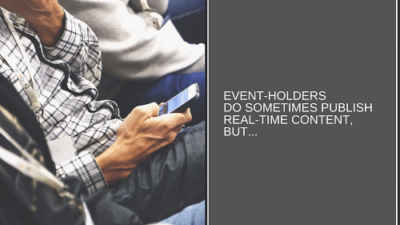If we define events as the gathering of people with a common interest at the same place and time, it makes sense that those people will be interested in different content than those who are elsewhere. That’s why there are event programs and event apps – because it’s most only those at the event that care what’s happening there. But the typical event app or website will have an event schedule, some background on the speakers and maybe a way to message other attendees. That’s fine, but there typically isn’t any real-time content to tell people what’s happening right now, or a video of the next speaker/artist/player getting ready backstage to build the excitement.
Would attendees value a push notification to let them know the merch shop is open, would they like a post containing a video of the artist doing sound check to let them know that the main act will be delayed? I think they would.
Don’t make me search
Event-holders do sometimes publish real-time content about what’s happening right now, but they usually sent it to Twitter, with a hashtag to try to surface it from the content firehouse. Attendees at a busy conference or event should be too engaged in what they’re doing to carefully tap in a hashtag and search for operational messages. No, Twitter is where outbound marketing content goes.
No-one is publishing real-time, relevant content directly to those at specific events. If Steve Krug was to write a 2019 sequel to his seminal UX bible Don’t Make Me Think it would be called Don’t Make Me Search. Users now expect relevant content and information served to them; none more so than those that have paid to be at an event. Essentially they have opted in with their attendance and time – the most valuable of commodities – and they expect that that should be enough.
The story behind the story
Did you know that 70%-90% of every sports broadcast is not live play. It’s all the other stuff – the behind the scenes, the story behind the story. Netflix knows this and has spent millions on a large slate of sporting content, but hosts no actual live sport. The story behind the story is just as valuable.
If our lives are now a multi-screen experience, why aren’t events? I thought the opportunity was so huge, I built a platform to solve the problem. The more real-time content that events rights-holders can capture and publish to the fans at the event, the better the event will be.
Life is messy and that’s fine
Events are unpredictable, messy, human, fun. That’s why we like them, and there’s so much more going on than is listed in the schedule.
Imagine you’re at a sports event and your team’s star player goes off injured. It’s the business end of the season. Is the player out until next year, or will she be back in 10 minutes? Your phone buzzes and you open the team’s app to the “At the game” section that your friends at home don’t see. You find a video of the team doctor assessing the injury in the locker room and the player giving the thumbs up. You breathe easier.
You’re at a music festival and it’s been wet. Your favourite band is on next but things are running a little behind, as they usually are. Your phone buzzes and the festival app tells you the band is 10 minutes away, then shows you clips of what’s on stage two and three right now to check out while you’re waiting. Then you see a video of your band playing mud cricket behind the stage, and you smile, clicking an offer to buy a “Mud Warriors” T-shirt they designed just in case.
That is the kind of engagement that every event needs.









